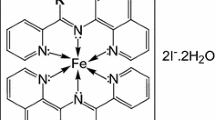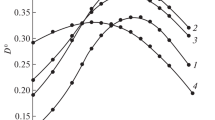Abstract
Base hydrolysis of [Cr(ox)2(quin)]3− (where quin2− is N,O-bonded 2,3-pyridinedicarboxylic acid dianion) causes successive ligand dissociation and leads to a formation of a mixture of oligomeric chromium(III) species, known as chromates(III). The reaction proceeds through [Cr(ox)(quin)(OH)2]3− and [Cr(quin)(OH)4]3− formation. Dissociation of oxalato ligands is preceded by the opening of the Cr-quin chelate-ring at the Cr–N bond. The kinetics of the chelate-ring opening and the first oxalate dissociation were studied spectrophotometrically, within the lower energy d–d band region at 0.4–1.0 M NaOH. The pseudo-first-order rate constants (k obs0 and k obs1) were calculated using SPECFIT software for an A → B → C reaction pattern. Additionally, kinetics of base hydrolysis of [Cr(ox)(quin)(OH)2]3− and cis-[Cr(ox)2(OH)2]3− were studied. The determined pseudo-first-order rate constants were independent of [OH−]. A mechanism is postulated that the reactive intermediate with the one-end bonded quin ligand, [Cr(ox)2(O-quin)(OH)]4−, formed in the first reaction stage, subsequently undergoes oxalates substitution. Kinetic parameters for the chelate-ring opening and the first oxalate dissociation were determined.





Similar content being viewed by others
References
Vergun O et al (1999) J Physiol 519:451. doi:10.1111/j.1469-7793.1999.0451m.x
Stone TW (1993) Pharmacol Rev 45:309
Smythe GA, Braga O, Brew BJ, Grant RS, Guillemin GJ, Kerr SJ, Walker DW (2002) Anal Biochem 301:21. doi:10.1006/abio.2001.5490
Sas K, Robotka H, Toldi J, Vecsei L (2007) J Neurol Sci 257:221. doi:10.1016/j.jns.2007.01.033
Harmon KM, Shaw KE (1999) J Mol Struct 513:219. doi:10.1016/S0022-2860(99)00118-0
Loring JS, Karlsson M, Fawcett WR, Casey WH (2001) Polyhedron 20:1983. doi:10.1016/S0277-5387(01)00798-7
Kita E, Gołembiewska K (2007) Transit Met Chem 32:56. doi:10.1007/s11243-006-0128-8
Goher MAS, Youssef AA, Zhou ZY, Mak TCW (1993) Polyhedron 12:1871. doi:10.1016/S0277-5387(00)81425-4
Okabe N, Miura J, Shomosaki A (1996) Acta Crystallogr Sect C 52:1610. doi:10.1107/S0108270196002314
Patric BO, Stevens CL, Storr A, Thompson RC (2003) Polyhedron 22:3025. doi:10.1016/S0277-5387(03)00433-9
Han Z-B, Ma Y, Sun Z-G, You W-S (2006) Inorg Chem Commun 9:844. doi:10.1016/j.inoche.2006.05.013
Vincent JB (2000) Acc Chem Res 33:503. doi:10.1021/ar990073r
Pan Q, Liu S, Tan Y-G, Bi Y-Z (2003) Agriculture 225:421
Slesinski RS, Clarke JJ, San RHC, Gudi R (2005) Mutat Res 585:86
Whittaker P, San RHC, Clarke JJ, Seifried HE, Dunkel VC (2005) Food Chem Toxicol 43:1619. doi:10.1016/j.fct.2005.05.003
Storrs RW, King SR (2007) US Patent Appl. Publ. US 2007 254,864 (Cl. 514-184; A61K31/555)
Kita E, Marai H, Zając K (2008) Transit Met Chem 33:211. doi:10.1007/s11243-007-9025-z
Kita E, Marai H, Iglewski Ł (2009) Transit Met Chem 34:75. doi:10.1007/s11243-008-9160-1
Kita E, Marai H, Jach K, Orłowska A (2009) Transit Met Chem 34:217. doi:10.1007/s11243-008-9181-9
Kita E, Marai H, Jasiński M, Drewa T (2008) Transit Met Chem 33:585. doi:10.1007/s11243-008-9084-9
Rao L, Zhang Z, Friese JI, Ritherdon B, Clark SB, Hess NJ, Rai D (2002) J Chem Soc Dalton Trans 267. doi:10.1039/b104154c
Basolo F, Pearson RG (1967) Mechanism of inorganic reactions, 2nd edn. Wiley, New York
Acknowledgments
Hasan Marai thanks Libyan Government for financial support of his Ph.D. studies in Poland.
Author information
Authors and Affiliations
Corresponding author
Rights and permissions
About this article
Cite this article
Kita, E., Marai, H. Kinetics and mechanism of base hydrolysis of chromium(III) complexes with oxalates and quinolinic acid. Transition Met Chem 34, 585–591 (2009). https://doi.org/10.1007/s11243-009-9234-8
Received:
Accepted:
Published:
Issue Date:
DOI: https://doi.org/10.1007/s11243-009-9234-8




